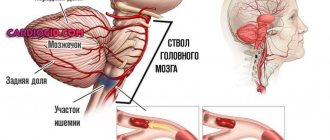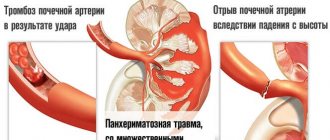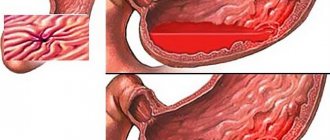The abdomen in the human body is the most unprotected area; injuries in this area occur frequently, especially in childhood. Most of them are not dangerous and do not require medical attention. But some injuries lead to bleeding. Parenchymal bleeding is one of the common reasons for hospitalization. If it is not detected and stopped in a timely manner, it will lead to complications and even death.
Types of bleeding
Bleeding is the leakage of blood from blood vessels. Most often it is caused by their damage. This may be a consequence of injury (which happens most often) or the consequences of pathological changes in the body. This “melting” of blood vessels can be observed in tuberculosis, oncological conditions, and ulcers of internal organs.
Bleeding is usually divided into external, when blood from a damaged vessel flows out through a wound or natural openings, and internal. In this case, blood accumulates in the cavities. The following types of external bleeding are distinguished:
- capillary - occur as a result of superficial damage, blood is released in small quantities, drop by drop;
- venous - occurs as a result of deeper injuries (cut, puncture wounds) and a large amount of dark red blood flows out;
- arterial - the cause is deep injuries in which the wall of the arteries is damaged, while the blood flows out in a pulsating stream and has a bright scarlet color;
- mixed bleeding can also occur with deep injuries, with both arteries and veins bleeding in the wound at the same time.
How does surgical treatment occur?
The methodology for stopping hemorrhage, when parenchymal bleeding is diagnosed, involves performing an operation, without which stopping the outflow of blood from the parenchyma is impossible. Surgical intervention has two main directions, which are carried out in parallel:
- Direct relief of effusion. The methodology of the operation depends directly on the location and scale of the effusion, and may include suturing, electrocoagulation or the application of specific sutures on the bleeding surface, as well as partial or absolute resection of the organ, sometimes with the need for its urgent transplantation.
- Restoration of blood volume indicators through the transfusion of biomaterial or the introduction of certain of its components, special solutions, which will stabilize pressure, reduce the criteria for deficiency of blood supply to organs and stop the development of their physiological deprivation.
Internal bleeding
Internal bleeding can also be classified according to the location of the process. With blows and injuries to the chest, bleeding may occur, in which blood flows into the pleural cavity. In this case, it accumulates there and compresses the lungs. Outwardly, this is manifested by difficulty breathing and increasing shortness of breath.
Bleeding in the abdominal cavity can be a consequence of diseases of the organs located in it; in women, it can be caused by an ectopic pregnancy, but most often the cause of internal bleeding in the abdominal cavity is blunt trauma to the abdomen, which is accompanied by rupture of the liver or spleen. In this case, they say that the bleeding is parenchymal. In addition, with such bleeding, blood can not only pour into the abdominal cavity, but also accumulate in the thickness of the tissues, saturating them.
Causes
The main causes of internal bleeding:
- Injury to blood vessels and organs.
- Viral diseases that disrupt the integrity of tissues, for example, tuberculosis.
- Malignant tumors at the last stage of progression cause bleeding of parenchymal organs during the disintegration of the neoplasm.
- Benign tumors if they rupture.
In addition to these factors, each individual organ has its own most common causes:
- Lung damage occurs when ribs are fractured. Therefore, if a rib fracture is suspected, tight bandaging is strictly prohibited. In addition, bleeding in the lungs occurs with tuberculosis and cancer. The main symptoms of bleeding in this organ are hemoptysis, low blood pressure and shortness of breath.
- Hepatic bleeding mainly occurs with penetrating wounds and blunt trauma to the abdomen. It occurs much less frequently when infected with parasites. It is characterized by the rapid development of peritonitis, acute pain syndrome and hemorrhagic shock.
- Spleen. Children are more susceptible to damage to this organ. Basically, bleeding under the capsule begins first. Only after a few days of overflow does the capsule rupture, and the accumulated blood enters the cavity.
- Hemorrhage in the kidneys occurs with strong impacts and compression, as well as rupture of cysts. Blood loss is accompanied by the appearance of blood in the urine and acute painful sensations.
Important information: How to treat diarrhea (loose stools) with blood in an adult and why there is bleeding from the anus
What is parenchyma
Parenchyma is a tissue that forms the basis of many internal organs. Anatomically, it is formed, depending on the task of the organ, by epithelial, nervous, muscle, myeloid or lymphoid tissue. Parenchymal organs are the liver, spleen, kidneys, various glands and even the brain. The peculiarity of these organs is that in each of them the parenchyma forms specialized structures that allow the organ to perform its functions. In the liver these are its lobules, in the kidneys - nephrons, in the spleen - follicles. In addition to the parenchyma, the structure of such organs includes stroma - a connective tissue base that performs supporting and trophic functions. When the smallest blood vessels (capillaries) supplying these organs are damaged, parenchymal bleeding occurs. It is often difficult to diagnose and therefore may have lost a lot of blood by the time help is given. That is why timely diagnosis and stopping of parenchymal bleeding is a priority task for the surgeon.
Parenchymal organs
All human internal organs can be divided into two large groups:
- Cavity,
- Parenchymatous.
With the cavitary, everything is very clear - this is the stomach, intestines, bladder. They have a cavity and a wall supplied with vessels. Bleeding from these organs will only be associated with vascular damage. If the vessel is small, then it is able to contract on its own, narrowing its lumen, and the bleeding will stop. But what are parenchymal organs?
They have a completely different structure:
- Liver,
- Lungs,
- Pancreas,
- Kidneys,
- Spleen.
There is no cavity in them, only the main tissue responsible for the function of this organ is parenchyma . It is permeated with many tiny vessels. When a parenchymal organ is damaged, bleeding develops from each of these capillaries.
An unpleasant feature of the parenchyma and its vessels is the inability to contract, stopping the bleeding on its own.
Where are parenchymal organs located?
Causes of parenchymal bleeding
The first place among the causes is unconditionally occupied by injury. Regardless of what caused it - a traffic accident, a blow or a fall from a height - even a minor impact can be enough to cause parenchymal bleeding. This is due to the fact that even a small tear in the organ capsule (and it is, as a rule, very delicate) is enough to cause the blood vessels that feed the parenchyma and are therefore present in large numbers to become damaged and blood begins to flow into the body cavity.
In addition to injuries, the following pathologies can cause parenchymal bleeding:
- tumors, both malignant and benign;
- infections (tuberculosis);
- pathologies of parenchymal organs (hemangioma);
- parasitic lesions;
- pathology of the blood coagulation system.
What happens in the body during parenchymal bleeding?
Violation of the integrity of blood vessels in the parenchyma of internal organs leads to the leakage of blood into adjacent tissues and cavities, for example, abdominal, pelvic, pleural. This process is called hemorrhage, and the location of the contents is called a hematoma.
Due to the high density of blood vessels in the parenchyma, blood leaks over the entire surface of the wound. Sometimes the early stages of internal bleeding are difficult to diagnose, since external signs are similar to the symptoms of many diseases.
The body cannot stop such bleeding without medical intervention: the outer part of the vessels is connected to the stroma surrounding the parenchyma, and spasm is impossible. Because of this, even at low intensity, blood loss is usually extremely high.
Over time, the concentration of blood cells decreases, anemia begins, and then hypoxia - oxygen starvation of the brain and heart. There is a malfunction in the functioning of all metabolic processes of the body. With severe blood loss, the development of hemorrhagic shock is possible - a serious complication leading to a sharp decrease in blood pressure and malfunction of many internal organs.
Parenchymal bleeding is divided into venous, arterial and capillary, in accordance with the type of damaged vessel. When the latter are deformed, the symptoms increase slowly; the onset of the process often goes unnoticed, which complicates diagnosis. Blood enters the cavities in small portions, gradually causing anemia and contributing to the development of inflammation of the peritoneum - peritonitis.
If the veins are damaged, the patient quickly loses large volumes of blood, and the risk of developing hemorrhagic shock increases. The processes may differ depending on which organ was damaged.
Liver
Most hepatic hemorrhages are associated with liver injury resulting from motor vehicle accidents.
Their severity in this case is divided into four degrees:
- shallow – up to 2 cm from the thickness of the liver;
- medium depth - from 2 cm to half the entire thickness;
- deep - more than 1/2 the thickness of the liver, up to through;
- organ rupture with separation and damage to arteries, veins and ducts.
The risk of bleeding is increased in patients with jaundice, previous malaria and alcoholics. With these diseases, the liver increases in size, stretching the surrounding connective tissue capsule. The liver tissue may not withstand this load and rupture.
A hematoma forms in the abdominal cavity, and bile peritonitis occurs due to the ingress of bile. The patient experiences severe pain. In the process, the hematoma may rupture. When the portal vein of the liver is deformed, bleeding occurs. It is characterized by a sudden, sharp onset of symptoms, severe blood loss and the risk of hemorrhagic shock.
Kidneys
The main causes of renal bleeding are blunt and acute injuries, hydronephrosis, in which the organ overflows with urine followed by its rupture, opening of a cyst in the parenchyma, neoplasms and infectious diseases. If the cause is a malignant tumor, long-term chronic bleeding is observed, followed by anemia and hypoxia.
The disease can pass unnoticed by the patient, since the spread of blood outside the kidney and the space around the organ is limited by a barrier of fatty tissue. It absorbs blood, and the disease remains undetected until significant blood loss leads to a deterioration in the patient's general condition and to kidney dysfunction. The main signs of renal bleeding are sharp pain in the lower back, hematuria - the presence of blood in the urine, and elevated temperature.
Lungs
Bleeding from the lungs is associated with mechanical trauma or vascular damage, with the presence of tumors, pneumonia, bronchiectasis, and infectious destruction. Viral diseases lead to impaired wall permeability and the formation of defects, which ends in damage to blood vessels.
The cause of bleeding can be foreign bodies in the respiratory tract. With pulmonary hemorrhage, blood enters the lumen of the bronchi and is coughed up. It exits through the respiratory tract, which facilitates diagnosis of the disease. In this case, the volume allocated to patients is more than 8 ml per day. It enters the respiratory tract from the lung tissue or from the bronchi as a result of a violation of the integrity of the vessels and organ parenchyma. The cough gets worse over time along with the amount of blood coughed up.
Spleen
Bleeding of the spleen occurs as a result of injury or rupture of the organ. Causes may include severe blows to the abdomen. Various pathologies: infectious diseases, lymphoma, malaria, hemolytic anemia, increase the risk of spleen injury.
There are several types of splenic rupture:
- organ parenchyma without damage to the capsule;
- capsules without damage to the parenchyma;
- simultaneous capsule and parenchyma;
- sequential parenchyma and then capsule - two-stage rupture.
Sometimes the latter happens in a non-standard way. For example, damage to the parenchyma is sealed by a thrombus, stopping bleeding. However, after a while, the blood clot is washed out by the flow, causing the process to happen again. Such cases complicate and delay diagnosis, increasing the risk of an unfavorable outcome of the disease.
Mechanism of blood loss
The consequence of bleeding in the body can be a hemorrhage (in this case, the gushing blood soaks into the surrounding tissues) or a hematoma. Then a cavity filled with blood forms in the tissue. With parenchymal bleeding, both of these options are possible. The danger is that the vessels feeding the parenchyma do not collapse due to their structure, which means that bleeding will continue. Even if it is not intense, the symptoms of anemia will still increase, and as a result, the organs and brain will suffer from hypoxia. With significant blood loss, hemorrhagic shock develops - a serious condition in which blood pressure significantly decreases and signs of multiple organ failure progress.
Signs of hemorrhage
More often than not, internal bleeding develops quickly. Sometimes it is slow, so clinical manifestations may be either absent or undetectable. Signs of this condition include:
- dizziness;
- rapid and severe fatigue;
- pale skin;
- drop in blood pressure;
- increased heart rate;
- chills;
- I'm thirsty.
In addition, there are general clinical manifestations of blood loss that occur regardless of which parenchymal organ is affected. Particular attention should be paid to the following symptoms:
- dyspnea;
- weakness;
- pressure in the chest area;
- change in urine color;
- acute pain in the peritoneum;
- coughing up blood.
With blood loss of any intensity, the patient experiences a gradual decrease in iron and red blood cells in the blood, as a result of which the symptoms of anemia increase. Over time, all internal organs, especially the heart and brain, will suffer from oxygen starvation. With significant bleeding, hemorrhagic shock develops. Each affected organ has its own signs of parenchymal bleeding:
| Parenchymal organs | Characteristic symptoms |
| Liver | Pain in the liver area, impaired consciousness, headaches, bloody vomiting, blood in the stool. |
| Kidneys | Red coloration of urine, severe pain in the lower back, nausea, vomiting, increased body temperature. |
| Lungs | Severe dry cough, mucous sputum mixed with blood clots, rapid breathing, wheezing. |
| Spleen | Muscle tension in the anterior abdominal wall, pain on the left side, tinnitus, vomiting, shortness of breath. |
Signs of parenchymal bleeding
Despite the obvious danger to the patient’s life, such bleeding cannot always be detected immediately. It often happens that blood loss occurs over a period of time, with virtually no effect on overall well-being. Parenchymal bleeding in the early stages can be suspected by general weakness, drowsiness, and dizziness. The patient experiences thirst, “sights” and darkening in the eyes, cold sweat. Fainting is possible. The degree of blood loss can be judged by factors such as pulse, blood pressure and other objective signs.
With minor blood loss, a slight decrease in blood pressure and increased heart rate (up to 80–90 beats per minute) are possible. In some cases, it goes away without obvious signs at all, which creates an even greater danger, since parenchymal bleeding cannot stop on its own.
Moderate blood loss is characterized by an increase in heart rate to 100 beats per minute or higher and a decrease in systolic pressure below 90 mmHg. Art. rapid breathing, pale skin, cold sticky sweat, cold extremities, dry mouth, severe weakness, apathy, adynamia, and lethargy are also noted.
In cases of severe blood loss, systolic pressure drops below 80 mm and the pulse rate may exceed 110 beats per minute. Breathing is shallow, very rapid, yawning, pathological drowsiness, hand tremors, decreased amount of urine output, severe pallor, marbling of the skin, lethargy or confusion, painful thirst, cyanosis of the extremities, acrocyanosis.
Main symptoms for all types
What signs indicate that there is internal bleeding in the body?
First of all, you need to take a close look at how the body works if a person has suffered an injury to the abdomen, chest or lower back. Symptoms include:
- The presence of hematomas on the body or rib fractures.
- The patient complains of pain in possible areas of bleeding, general weakness of the body.
- Deterioration in a person’s appearance, namely, pale skin, the appearance of cold sweat. Facial features become sharp.
- Rapid heartbeat, low blood pressure.
Life-threatening blood loss
Massive internal bleeding is characterized by a decrease in pressure to 60 and an increase in heart rate to 140–160 beats per minute. Cheyne-Stokes breathing (respiratory movements first deepen and become more frequent, but on the 5th-7th inhalation their intensity begins to decrease, after which there is a pause). Consciousness is confused or absent, delirium, the skin is sharply pale, sometimes with a grayish tint. Facial features become sharper, eyes become sunken.
Fatal blood loss (as a rule, it is a third of the volume, that is, 1.5–2 liters) is accompanied by the development of a coma. In this case, the pressure drops below 60 mm or is not detected at all, pulse contractions are reduced to 2–10 beats, convulsions, agonal breathing are observed, the pupils are dilated, the skin is dry and “marbled.” As a rule, this condition is irreversible - agony and then death inevitably occur.
Complications
Severe blood loss is scary not only in itself.
Ultimately, it becomes complicated by life-threatening conditions. These pathologies require emergency surgery along with highly qualified care from resuscitators:
- Hemorrhagic shock
- Disseminated intravascular coagulation syndrome (DIC).
Hemorrhagic shock develops when 30 percent or more of blood is lost. It is manifested by loss of consciousness, almost complete absence of pulse and blood pressure below 60 mm Hg. Treatment for shock is provided in the intensive care unit with the help of transfusions of red blood cells, plasma and colloid solutions.
DIC is a fatal complication of bleeding. Blood loss reaches critical levels, such that the blood loses its ability to clot. Moreover, it can begin to flow not only from the injured area, but also from any organs. Mortality in DIC is high even in an intensive care unit.
Parenchymal bleeding - first aid
Everyone knows very well that very often timely first aid can save a patient’s life. Unfortunately, the same cannot be said about internal bleeding. Parenchymal bleeding cannot be stopped or reduced with available means; the most important thing that can be done for the victim is to take him to a surgical hospital as soon as possible, that is, call an ambulance.
To prevent the patient’s condition from worsening, before her arrival you can provide the following assistance for parenchymal bleeding:
- give the victim a horizontal position, with legs raised, if hemorrhage into the abdominal cavity is possible, or a semi-sitting position if hemothorax is suspected;
- Apply cold to the area of suspected bleeding.
Note! Patients with symptoms of internal bleeding are strictly prohibited from heating the sore area, inducing vomiting or doing enemas and giving medications that stimulate cardiac activity.
What to do in this case?
If there is a suspicion of parenchymal bleeding, first aid is to call an ambulance. It should be understood that this type of bleeding will not go away on its own. Therefore, at the slightest suspicion, you should immediately call doctors and go to a surgical hospital.
There an accurate diagnosis will be made and emergency surgery will be performed. Any delay can lead to the death of a person. It is important to monitor the condition of the body and well-being, especially if you have received any injuries that could damage organs such as the liver, lungs, kidneys and spleen.
Also, the presence of bruises and bruises on the body, pain and dizziness should alert a person and force him to seek qualified help from specialists. It’s good if there are relatives or people nearby who are able to provide assistance.
It is important to provide the patient with physical peace and emotional support.
Treatment
To date, the only way to stop parenchymal bleeding is surgical intervention. As a rule, this happens during an emergency operation, before which laboratory tests are performed to evaluate the hematocrit, hemoglobin and red blood cell levels, an ultrasound of the abdominal cavity, and an x-ray.
There are several ways to stop parenchymal bleeding. This:
- organ resection;
- drying out the oil seal;
- electrocoagulation of blood vessels;
- suturing of blood vessels;
- embolization of the feeding vessel;
- use of hemostatic sponges.
Along with stopping bleeding, the most important task is to compensate for blood loss, restore the volume of circulating fluid and improve microcirculation. For this purpose, blood transfusions, plasma and blood substitutes are carried out, as well as administration of a 5% glucose solution and saline solution.
How to stop bleeding
There are several ways to stop bleeding from parenchymal organs:
- Using a special hemostatic sponge.
- By suturing the omentum or removing the damaged part of the organ.
- Electrical coagulation.
- The use of hemostatic drugs (Vikasol, Etamzilat).
First aid
If a person has symptoms that indicate parenchymal bleeding, then he or she must be taken to the hospital immediately. Standard methods of stopping bleeding, which include applying a bandage or tourniquet, are useless in this case. Only a surgeon can help a person, since there are no ways to stop parenchymal bleeding at home. But at the same time, there are several recommendations on what to do when a person develops internal bleeding. First aid is provided in the following order:
- First you need to call an ambulance and describe the person’s condition as accurately as possible.
- It is necessary to place the patient on a horizontal surface, such as the ground, with his legs elevated.
- Ice should be applied to the suspected bleeding site.
Surgery
Surgery is the main way to stop blood from internal bleeding. After examining the patient (x-ray, ultrasound of the abdominal cavity), an urgent operation is performed. If questionable test results appear, the surgeon can begin laparoscopic diagnosis. Methods to stop hemorrhage:
- Suturing the omentum.
- Use of hemostatic sponges.
- Application of complex sutures to damaged tissue.
- Embolization of the feeding vessel.
- Removal of the affected part of the organ.
- Electrocoagulation of blood vessels.
Simultaneously with the surgical operation, the patient is given a transfusion of donor blood and the administration of saline solutions. The main task of the surgeon is to prevent the progression of multiple organ failure and disseminated intravascular coagulation syndrome, in which blood clotting is impaired.
Important information: What to do when a vessel (capillary) or vein in the leg bursts and how to treat it
Providing timely assistance
When many diseases appear, especially when bleeding occurs, medicine assigns a special role to the correct provision of first aid to the patient, however, parenchymal bleeding is an exception to the rule. Hemorrhages from the parenchyma cannot be stopped at home, therefore the only help that can save a person’s life is his immediate delivery to the surgical department.
Before the ambulance team arrives, you should not give the patient any medications; it is important to ensure the person’s peace by laying him on a horizontal surface. If there is a suspected effusion of blood into the abdominal cavity, it is necessary to place a bolster, blanket or other available object under the patient’s feet so that his lower limbs are raised approximately forty-five degrees relative to the surface, which will minimize the effusion and pressure drop.
We suggest you read: How to raise blood pressure after surgery
Cooling the area of suspected parenchymal rupture will help reduce the intensity of the effusion. Doctors, in the process of transporting a patient, depending on vital signs, can use infusion therapy methods, among which intravenous administration of saline is most often practiced, in order to normalize pressure.
Successful control of bleeding and subsequent recovery largely depend on how correctly and timely first aid for bleeding was provided.
Conventional measures (pressing the vessel, applying a tourniquet) do not work in this case. The main task is to deliver the patient to the nearest medical facility as soon as possible.
Before the ambulance arrives, the person should be laid down and cold applied to the suspected site of bleeding. To do this, you can use a heating pad with ice, thermal packs, or a regular bottle of cold water. With a rapid decrease in blood pressure, the leg end is raised centimeters above the level of the heart.
Constant monitoring of breathing and heart rate is important, and if necessary, resuscitation measures are carried out. It is contraindicated to give the victim any medications, including painkillers, food or drink; if you are very thirsty, you are allowed to rinse your mouth with water.











